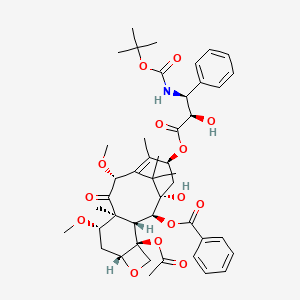



1. Jevtana
2. Kabazitaxel
1. 183133-96-2
2. Jevtana
3. Taxoid Xrp6258
4. Txd 258
5. Xrp-6258
6. Cabazitaxelum
7. Xrp6258
8. Xrp 6258
9. Jevtana (tn)
10. Nsc-761432
11. Chebi:63584
12. Txd-258
13. 51f690397j
14. Kabazitaxel
15. Jevtana Kit
16. Cabazitaxel (jevtana)
17. (2ar,4s,4as,6r,9s,11s,12s,12ar,12bs)-12b-acetoxy-9-(((2r,3s)-3-((tert-butoxycarbonyl)amino)-2-hydroxy-3-phenylpropanoyl)oxy)-11-hydroxy-4,6-dimethoxy-4a,8,13,13-tetramethyl-5-oxo-2a,3,4,4a,5,6,9,10,11,12,12a,12b-dodecahydro-1h-7,11-methanocyclodeca[3,4]benzo[1,2-b]oxet-12-yl Benzoate.
18. Cabazitaxel Acetonate
19. Cabazitaxel Acetonate [jan]
20. Cabazitaxel Injection
21. Cabazitaxel [usan:inn]
22. Jevanta
23. Txd258
24. Unii-51f690397j
25. Rpr 116258a
26. Rpr-116258a
27. Cabazitaxel [mi]
28. Cabazitaxel [inn]
29. Cabazitaxel (usan/inn)
30. Cabazitaxel [usan]
31. Cabazitaxel [vandf]
32. Cabazitaxel [mart.]
33. Cabazitaxel [who-dd]
34. Schembl179674
35. Cabazitaxel [ema Epar]
36. Gtpl6798
37. Chembl1201748
38. Amy4317
39. Cabazitaxel [orange Book]
40. Dtxsid40171389
41. Ex-a838
42. Mfcd18827611
43. Nsc761432
44. Nsc794609
45. S3022
46. Zinc85536932
47. Akos032947285
48. Ccg-270519
49. Cs-0972
50. Db06772
51. Nsc 761432
52. Nsc-794609
53. Ncgc00346704-01
54. Ncgc00346704-03
55. As-75355
56. Hy-15459
57. A25044
58. D09755
59. Ab01273971-01
60. Ab01273971_02
61. Q412963
62. Sr-01000941585
63. J-011721
64. J-519981
65. Sr-01000941585-1
66. (((tertbutoxy)carbonyl)amino)-2-hydroxy-3-phenylpropanoate1-hydroxy-7beta,10beta-dimethoxy-9-oxo-5beta,20-epoxytax-11-ene-2alpha,4,13alpha-triyl 4-acetate 2-benzoate 13-((2r,3s)-3-
67. (1s)-5beta,20-epoxy-9-oxo-7beta,10beta-dimethoxytaxa-11-ene-1,2alpha,4alpha,13alpha-tetraol 2-benzoate 4-acetate 13-[(2r,3s)-2-hydroxy-3-(tert-butoxycarbonylamino)-3-phenylpropionate]
68. (1s,2s,3r,4s,7r,9s,10s,12r,15s)-4-(acetyloxy)-15-{[(2r,3s)-3-{[(tert-butoxy)carbonyl]amino}-2-hydroxy-3-phenylpropanoyl]oxy}-1-hydroxy-9,12-dimethoxy-10,14,17,17-tetramethyl-11-oxo-6-oxatetracyclo[11.3.1.0(3),(1)?.0?,?]heptadec-13-en-2-yl Benzoate
69. (1s,2s,3r,4s,7r,9s,10s,12r,15s)-4-(acetyloxy)-15-{[(2r,3s)-3-{[(tert-butoxy)carbonyl]amino}-2-hydroxy-3-phenylpropanoyl]oxy}-1-hydroxy-9,12-dimethoxy-10,14,17,17-tetramethyl-11-oxo-6-oxatetracyclo[11.3.1.0^{3,10}.0^{4,7}]heptadec-13-en-2-yl Benzoate
70. (2alpha,5beta,7beta,10beta,13alpha)-4-acetoxy-13-({(2r,3s)-3-[(tert-butoxycarbonyl)amino]-2-hydroxy-3-phenylpropanoyl}oxy)-1-hydroxy-7,10-dimethoxy-9-oxo-5,20-epoxytax-11-en-2-yl Benzoate
71. (2ar,4s,4as,6r,9s,11s,12s,12ar,12bs)-12b-acetoxy-9-(((2r,3s)-3-((tert-butoxycarbonyl)amino)-2-hydroxy-3-phenylpropanoyl)oxy)-11-hydroxy-4,6-dimethoxy-4a,8,13,1
72. (2ar,4s,4as,6r,9s,11s,12s,12ar,12bs)-12b-acetoxy-9-(((2r,3s)-3-((tert-butoxycarbonyl)amino)-2-hydroxy-3-phenylpropanoyl)oxy)-11-hydroxy-4,6-dimethoxy-4a,8,13,13-tetramethyl-5-oxo-2a,3,4,4a,5,6,9,10,11,12,12a,12b-dodecahydro-1h-7,11-methanocyclodeca[3,4]benzo[1,2-b]oxet-12-yl Benzoate
73. [(1s,2s,3r,4s,7r,9s,10s,12r,15s)-4-acetyloxy-1-hydroxy-15-[(2r,3s)-2-hydroxy-3-[(2-methylpropan-2-yl)oxycarbonylamino]-3-phenylpropanoyl]oxy-9,12-dimethoxy-10,14,17,17-tetramethyl-11-oxo-6-oxatetracyclo[11.3.1.03,10.04,7]heptadec-13-en-2-yl] Benzoate
74. 1-hydroxy-7,10-dimethoxy-9-oxo-5,20-epoxytax-11-ene-2,4,13-triyl 4-acetate 2-benzoate 13-((2r,3s)-3-(((tertbutoxy)carbonyl)amino)-2-hydroxy-3-phenylpropanoate)
75. 1-hydroxy-7.beta.,10.beta.-dimethoxy-9-oxo-5.beta.,20-epoxytax-11-ene-2.alpha.,4,13.alpha.-triyl 4-acetate 2-benzoate 13-((2r,3s)-3-(((tert-butoxy)carbonyl)amino)-2-hydroxy-3-phenylpropanoate)
76. Benzenepropanoic Acid, Beta-[[(1,1-dimethylethoxy)carbonyl]amino]-alpha-hydroxy-, (2ar,4s,4as,6r,9s,11s,12s,12ar,12bs)-12b-(acetyloxy)-12-(benzoyloxy)-2a,3,4,4a,5,6,9,10,11,12,12a,12b-dodecahydro-11-hydroxy-4,6-dimethoxy-4a,8,13,13-tetramethyl-5-oxo-7,11-methano-1h-cyclodeca[3,4]benz[1,2-b]oxet-9-yl Ester, (alphar,betas)-
| Molecular Weight | 835.9 g/mol |
|---|---|
| Molecular Formula | C45H57NO14 |
| XLogP3 | 2.7 |
| Hydrogen Bond Donor Count | 3 |
| Hydrogen Bond Acceptor Count | 14 |
| Rotatable Bond Count | 15 |
| Exact Mass | 835.37790549 g/mol |
| Monoisotopic Mass | 835.37790549 g/mol |
| Topological Polar Surface Area | 202 Ų |
| Heavy Atom Count | 60 |
| Formal Charge | 0 |
| Complexity | 1690 |
| Isotope Atom Count | 0 |
| Defined Atom Stereocenter Count | 11 |
| Undefined Atom Stereocenter Count | 0 |
| Defined Bond Stereocenter Count | 0 |
| Undefined Bond Stereocenter Count | 0 |
| Covalently Bonded Unit Count | 1 |
| 1 of 2 | |
|---|---|
| Drug Name | Jevtana kit |
| Active Ingredient | Cabazitaxel |
| Dosage Form | Solution |
| Route | Iv (infusion) |
| Strength | 60mg/1.5ml (40mg/ml) |
| Market Status | Prescription |
| Company | Sanofi Aventis Us |
| 2 of 2 | |
|---|---|
| Drug Name | Jevtana kit |
| Active Ingredient | Cabazitaxel |
| Dosage Form | Solution |
| Route | Iv (infusion) |
| Strength | 60mg/1.5ml (40mg/ml) |
| Market Status | Prescription |
| Company | Sanofi Aventis Us |
For treatment of patients with hormone-refractory metastatic prostate cancer previously treated with a docetaxel-containing treatment regimen.
FDA Label
Jevtana in combination with prednisone or prednisolone is indicated for the treatment of patients with hormone-refractory metastatic prostate cancer previously treated with a docetaxel-containing regimen.
Treatment of prostate cancer
Treatment of patients with hormone refractory metastatic prostate cancer previously treated with a docetaxel-containing regimen.
Cabaitaxel has anti-tumour properties and is effective against docetaxel-sensitive and -insensitive tumours.
L01CD
L01CD04
L01CD04
L - Antineoplastic and immunomodulating agents
L01 - Antineoplastic agents
L01C - Plant alkaloids and other natural products
L01CD - Taxanes
L01CD04 - Cabazitaxel
Absorption
After an intravenous dose of cabazitaxel 25 mg/m2 every three weeks to a population of 170 patients with solid tumors, the mean Cmax in patients with metastatic prostate cancer was 226 ng/mL (CV 107%) and was reached at the end of the one-hour infusion (Tmax). The mean AUC in patients with metastatic prostate cancer was 991 ng.h/mL (CV 34%). Administration with prednisone or prednisolone do not effect the pharmacokinetic profile of cabazitaxel.
Route of Elimination
After a one-hour intravenous infusion [14C]-cabazitaxel 25 mg/m2, approximately 80% of the administered dose was eliminated within 2 weeks. Cabazitaxel is mainly excreted in the feces as numerous metabolites (76% of the dose); while renal excretion of cabazitaxel and metabolites account for 3.7% of the dose (2.3% as unchanged drug in urine).
Volume of Distribution
The volume of distribution (Vss) was 4,864 L (2,643 L/m2 for a patient with a median BSA of 1.84 m2) at steady state. Compared to other taxanes, penetrates the CNS to a greater extent.
Clearance
Cabazitaxel has a plasma clearance of 48.5 L/h (CV 39%; 26.4 L/h/m2 for a patient with a median BSA of 1.84 m2) in patients with metastatic prostate cancer.
Cabazitaxel is extensively metabolized in the liver (>95%), mainly by the CYP3A4/5 isoenzyme (80% to 90%), and to a lesser extent by CYP2C8 which results in 20 different metabolites. Two of these metabolites are active demethylated derivatives of cabaxitaxel and referred to as RPR112698 and RPR123142 respectively. Docetaxel is another metabolite of cabazitaxel. Cabazitaxel is the main circulating moiety in human plasma.
Following a one-hour intravenous infusion, plasma concentrations of cabazitaxel can be described by a three-compartment pharmacokinetic model with -, -, and - half-lives of 4 minutes, 2 hours, and 95 hours, respectively.
Cabazitaxel is a microtubule inhibitor. Cabazitaxel binds to tubulin and promotes its assembly into microtubules while simultaneously inhibiting disassembly. This leads to the stabilization of microtubules, which results in the interference of mitotic and interphase cellular functions. The cell is then unable to progress further into the cell cycle, being stalled at metaphase, thus triggering apoptosis of the cancer cell.